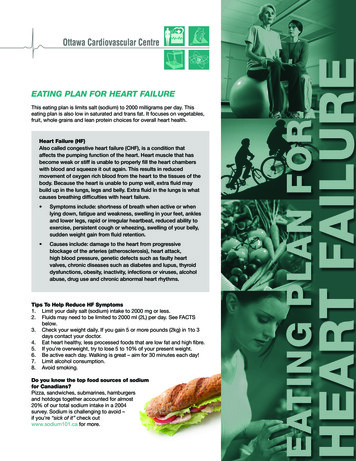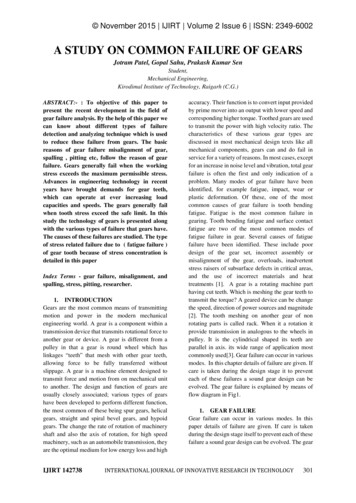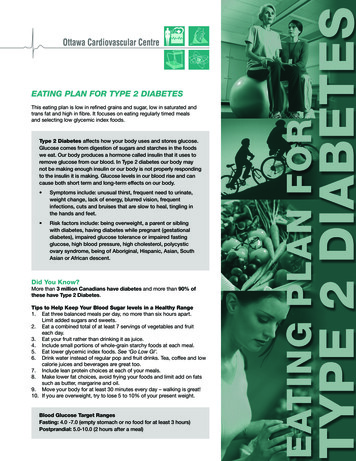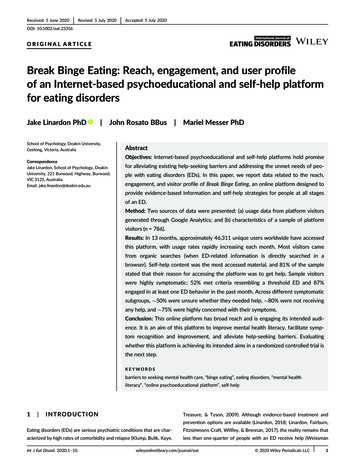
Transcription
EATING PLAN FOR HEART FAILUREThis eating plan is limits salt (sodium) to 2000 milligrams per day. Thiseating plan is also low in saturated and trans fat. It focuses on vegetables,fruit, whole grains and lean protein choices for overall heart health.Heart Failure (HF)Also called congestive heart failure (CHF), is a condition thataffects the pumping function of the heart. Heart muscle that hasbecome weak or stiff is unable to properly fill the heart chamberswith blood and squeeze it out again. This results in reducedmovement of oxygen rich blood from the heart to the tissues of thebody. Because the heart is unable to pump well, extra fluid maybuild up in the lungs, legs and belly. Extra fluid in the lungs is whatcauses breathing difficulties with heart failure. Symptoms include: shortness of breath when active or whenlying down, fatigue and weakness, swelling in your feet, anklesand lower legs, rapid or irregular heartbeat, reduced ability toexercise, persistent cough or wheezing, swelling of your belly,sudden weight gain from fluid retention. Causes include: damage to the heart from progressiveblockage of the arteries (atherosclerosis), heart attack,high blood pressure, genetic defects such as faulty heartvalves, chronic diseases such as diabetes and lupus, thyroiddysfunctions, obesity, inactivity, infections or viruses, alcoholabuse, drug use and chronic abnormal heart rhythms.Tips To Help Reduce HF Symptoms1. Limit your daily salt (sodium) intake to 2000 mg or less.2. Fluids may need to be limited to 2000 ml (2L) per day. See FACTSbelow.3. Check your weight daily. If you gain 5 or more pounds (2kg) in 1to 3days contact your doctor.4. Eat heart healthy, less processed foods that are low fat and high fibre.5. If you’re overweight, try to lose 5 to 10% of your present weight.6. Be active each day. Walking is great – aim for 30 minutes each day!7. Limit alcohol consumption.8. Avoid smoking.Do you know the top food sources of sodiumfor Canadians?Pizza, sandwiches, submarines, hamburgersand hotdogs together accounted for almost20% of our total sodium intake in a 2004survey. Sodium is challenging to avoid –if you’re “sick of it” check outwww.sodium101.ca for more.
Heart Failure FACTS – Focus on Salt and FluidExcess salt or sodium in the diet causes the body to retain more fluid.Extra body fluid increases the work for the failing heart pump. This causes it to become progressively weaker. By reducing thesalt you consume, you help your body to maintain a better fluid balance, manage the symptoms of heart failure and protect yourhearts pumping ability. Your doctor may advise you to limit the fluids you drink if reduction of salt and addition of medications toremove excess water from your body are not enough to control your symptoms.Reducing SaltSalt from the foods you eat will hold more water, or fluid, in the body. This fluid retention contributes to swelling in the feet, ankles,legs and belly and congestion in the lungs making you feel short of breath.Reducing salt is not easy because many of the foods we eat are processed or prepared with added salt. Cooking more fromscratch and reading labels to identify foods with less salt will be a very important part of managing your heart failure. Keep a record of your salt intake for the day. You are aiming for less that 2000 mg in total. Use the chart below, informationfrom the package or online sites such as www.eatracker.ca or www.calorieking.com to determine the salt you eat.Review your recipes. Remove added salt and replace high sodium foods with low or no sodium options. See the next pagefor a list of foods to avoid.Take the salt-shaker off the table and do not add salt in cooking. Try seasoning your food with herbs, spices and garlic.Lemon juice enhances our sense of saltiness in food.Read the Nutrition Facts Tables when shopping. Choose packaged foods with less than 200 mg of sodium per serving.Read ingredient lists. Foods listing salt or sodium at the beginning of the ingredient list or repeated times in the list are high insalt.Avoid fast food restaurants. Many menu items will have as much as your total daily salt intake in one serving! If it can’t beavoided, review the nutrition information available in store or on line and choose options with less salt and limit the frequencyof eating there.Focus on farm fresh, minimally processed foods. Fill your meals with vegetables, whole grains or starch and lean meat, fish,poultry or vegetarian protein choices such as beans, nuts or eggs. Select lower fat dairy choices. Replace salty, high fatsnacks with fruit or vegetable based snacks. The DASH Eating plan is a great example of this style of eating. On the web,enter Your Guide to Lowering Blood Pressure with DASH into your search engine for a complete guide or consult with aregistered dietitian for details.More on general heart healthy eating can be found in Eating Plan for Hypertension and Eating Plan for High Cholesterolavailable in our clinic or on line at www.ottawacvcentre.com.Did You Know?One teaspoon of salt containsapproximately 2300 mg of sodium.Your total daily intake, both what is inthe foods you eat and what you add toyour foods, should be less that what ateaspoon would hold.Homemade Herb BlendThis multi-purpose salt free seasoning can replace the salt in your table topshaker and is great in casseroles, soups and just about any savory dishyou would otherwise salt.1 Tbsp garlic powder1 tsp each of dried, crumbled: basil, marjoram, thyme, parsley, savory, sage1 tsp each of ground mace (or nutmeg), onion powder, pepper½ tsp cayenne (optional)In a small bowl, mix together all ingredients until well blended. Store in a jarwith a tight fitting lid in a cool, dry place for up to 6 months.Source: AHA Low Salt Cookbook- 2nd ed.Spice it Up!Low salt doesn’t have to mean bland and blah! Try adding flavor with fresh or frozen herbs and spices such as basil,parsley, ginger, garlic, oregano, and more! Find inspiration in these low sodium recipe collections: Hold the Salt byMaureen Tilley, RD, Delicious Dash Flavours by Sandra Nowlan or The No Salt, Lowest Sodium Cookbook by Donald Gazzaniga.
Where’s The Salt?Although about 80% of the salt we eat is added during processing and preparation, some salt does occur naturally in foods. Hereare some details on the amount of salt in food.FOODSODIUM (MG)VEGETABLES1-70140-460Tomato juice, canned, ½ c330Whole GrainsCooked cereal, rice, pasta (unsalted) ½ c0-5Ready to eat cereal, 1 cBread, 1 sliceSODIUM (MG)FRUITFresh or frozen ½ cCanned or ‘sauced’ ½ cFOOD0-360110-175LOW-FAT OR FAT-FREE MILK & MILK PRODUCTSFresh, frozen, canned, ½ c0-5Dried fruit0-15NUTS, SEEDS & LEGUMESPeanuts, salted, ½ c120Peanuts, unsalted, ½ c0-5Beans, cooked from dried or frozen,unsalted, ½ c0-5Beans, canned, ½ c400LEAN MEATS, FISH & POULTRYMilk, 1 c107Fresh meat, fish , poultry, 3 oz30-90Yogurt, 1c175Tuna canned, water packed, noadded salt, 3 oz35-45Natural Cheese, 1 ½ oz110-450Processed Cheese, 2 oz600Tuna canned water pack 3ozHam, lean, roasted, 3oz230-3501,020Fluids and Heart FailureThe most effective way of reducing the fluid your body retains is to reduce your salt intake. If your heart failure is more advancedor your body continues to retain fluid despite low salt eating and use of diuretic medications (‘water’ pills), your doctor may adviseyou to limit your beverages to 2L or 2000ml per day.Tips to help: Limit coffee or caffeine-containing beverages to 4 or less cups per day. Alcohol should be limited or avoided. If allowed, Men should consume 2 or fewer standard drinks per day and women shouldconsume no more than 1 standard drink per day. Keep a record and count all fluids consumed including coffee, tea, milk, juices, soups, water, pop, alcohol and any otherliquids consumed. 1 cup 8oz 250ml Measure your usual cups and glasses to determine how much they hold. You may want to keep an empty 2L bottle on your kitchen counter. Each time you have a drink, pour water of equal volumeinto the 2L bottle. As the bottle fills it will be a visual reminder that you are reaching your 2L limit. If you have trouble with dry mouth or thirst, try sucking on mints, chewing gum or freezing small fruit like berries or grapesand sucking on these. All of this stimulates saliva production that will wet your mouth.SupplementsCheck with your Doctor, Dietitian or Pharmacist before starting a supplement. Heart Healthy Mixture 1/3 ground flax, 1/3 oat bran and 1/3 psyllium. Use 2 Tablespoons per day added to foods orbeverages. Omega 3 fish oil supplements – doses of 1000 mg/day of EPA DHA have been shown to be safe and beneficial for overallheart health but no specific benefits have been found for those with heart failure. Caution: Salt substitutes based on potassium such as “No Salt” or “Half Salt” are not recommended with some heart failuremedications.
To Reduce WeightIf you are overweight a gradual reduction of 5-10% of your initial weight can reduce heart failure symptoms. Suggestionsinclude: Eat smaller portions of foods and remember the balance of foods on your plate: 1/4 protein, 1/4 starch (includingpotatoes), 1/2 vegetables Eat 3 meals per day, no more than 6 hours apart. Don’t skip meals. Snack with fruit between meals. Choose foods lower in fat and sugar. Eating strategies including low glycemic index choices can be helpful. Learnmore from a registered dietitian. Aim for a maximum weight loss of 1- 2 lbs (0.5 -1 kg) per week.“Waist loss” is as important as weight loss. For tips on how to trim your waist see our ‘Waisting Away – HealthyWeight Management’ nutrition fact sheet.BreakfastPortions to Live By ne serving of whole grains is 1/2 cup cooked,Onot the 3 or more cups served in most restaurants!Too much of a goodthing is not a good thing.For more details on healthy portions seeEating Well with Canada’s Food Guideonline at tLunch & SupperProteinStarchVegetablesDecoding Food LabelsThe Nutrition Facts table found on the side of packaged food can help you make betterfood choices. Always check the serving size first and consider this in relation to howmuch of the food you usually eat.Look for choices with less fat, saturated fat, cholesterol and sodium. Look for choicesthat give you more fibre.Learn more about using food labels to make healthy choices on the web:Health Canada – /index-eng.phpHealthy Eating Is In Store for You – www.healthyeatingisinstore.caGeneral Healthier Eating Guidelines Start with a balanced breakfast and follow up with a balanced lunch and supper.Add colour with fruit and vegetables. Eat your choices more often than drinking them as juice for more fibre andfewer calories.Whole grain starchy food choices include whole wheat pasta, whole grain bread, brown rice, whole wheatcouscous, barley, quinoa or oats.An eating pattern rich in plant based foods is rich in fibre. Fibre rich foods balance blood sugar, keep you feelingfull, lower cholesterol and blood pressure. (and keep you regular!)Protein choices include low fat dairy or alternative choices such as milk, yogurt, cheese and lean meat andalternative choices such as lean beef, pork, chicken, fish, eggs, tofu, beans, lentils, nuts and seeds.Choose milk and yogurt with milk fat percent (%MF) of 1% or less. Cheese should be 20%MF or less. Lower fatfortified soy milk is also a great option.Lean meats have less “marbling” or white fat throughout the meat. Remove skin from poultry. Use cooking methodssuch as grilling, broiling, poaching or stir-frying in a non-stick pan to reduce fat. Try a “meatless” meal includingbeans, tofu or lentils for less fat and more fibre.
Restricted Sodium Eating Plan1000-2000mg sodium/day. Reminder: read food labels for sodium content.FOODS TO CHOOSEWhole Grains Fresh breads (without cheese), pasta, rice Cooked cereals without salt Unsalted and reduced salt crackers (choose low-fat) Choose whole and multigrain productsFOODS TO LIMIT OR AVOID Crackers, bread, or rolls with salted topsPackaged breading, stuffing, bread or biscuit mixesPackaged instant cooked cerealsPre-seasoned/flavoured rice or pasta productsCommercial waffles, pancakes and muffinsVegetables and Fruit All fruits and fruit juices (without sodium additives) Fresh/frozen (no salt added) vegetables Low sodium canned vegetables Low sodium tomato or vegetable juice Low sodium tomato paste, canned tomatoesand tomato sauce Regular canned vegetables and vegetable juiceArtificial fruit flavoured crystals with sodiumPickles vegetables (e.g. sauerkraut)Instant or canned potatoesRegular canned tomatoes, tomato/spaghetti sauceNo canned tomato/vegetable/clamato juice(unless low sodium)Milk and Alternatives Milk, yogurt, cream, sour cream - choose low fat Low sodium cheese and cottage cheese Regular and processed cheese slices and spreadsButtermilk, malted milk, evaporated orcondensed milkHot chocolate mixes Meat and Alternatives Meat, poultry, fish without salt or sodium products Eggs, tofu, legumes (without added sodium) Unsalted peanut butter, nuts and seeds Choose low-fat protein choices Fats and Oils Any except those on opposite list (in moderation)Salted, smoked, cured, or pickled meat, fish, andpoultry: luncheonmeats, bacon, ham, sausages, wieners, sardines,herring, pickled eggsSalted peanut butter, nuts and seedsConvenience foods (e.g. canned: stews, pastas,beans) Bacon fatPackaged gravies, sauces, salad and vegetable dipsCommercial salad dressings, salted margarineSweets Any except those on opposite list (in moderation) Commercial cakes, pies, pastries, dessert,and instant pudding mixesSnack Foods – Unsalted Only! Unsalted popcorn (air popped) Salted chips, cheezies, pretzels, and popcornBeveragesIf fluid restricted, limit to 2000ml (8 cups) fluid per day Any except those on opposite list Water treated with water softenerMineral waters with sodium content greater than250 mg sodium/LOvaltine, sports beverages such as Gatorade
FOODS TO CHOOSEFOODS TO LIMIT OR AVOIDSoups Low sodium broth or canned soups, homemade soups(made without salt) Meat extracts (e.g. boullion, Oxo)Regular canned soups or dried soups mixes Sea salt, seaweed, Salted herbs (e.g. garlic salt)Meat tenderizersMSG (monosodium glutamate)Salt substitutes containing salt (e.g. Lite Salt)Regular pickles, olives, and relishesSoya sauce and oriental sauces (e.g. teriyaki) Most contain very high levels of salt/sodium. To verifythe sodium content of foods, ask for the company’s“Nutritional Guide” or go to their website.Seasonings and Condiments Unsalted herbs and spices Dry mustard Vanilla extract, lemon, lime, vinegar, cocoa Salt-free condiments (e.g. salt-free ketchup) Limit of 1 tsp (5 mL) per day of the following: barbeque,steak and Worcestershire sauces, horseradish, ketchup,prepared mustard, relish, salsaFast Food Plain ‘Garden’ salad – use a squeeze of lemon insteadof dressing Plain baked potato – can top with 1 tsp of soft margarineand chivesNotes:Other Nutrition Fact Sheets Available:Eating Plan for High CholesterolEating Plan for HypertensionEating Plan for Type 2 DiabetesWaisting Away – Healthy Weight ManagementPotassium Modified Eating PlanPlease visit www.cvtoolbox.com for moreinformationOttawa Cardiovascular Centre502-1355 Bank StreetOttawa, ON K1H 8K7Phone: (613) 738-1584Email: admin@ottawacvcentre.comEating Plan for Heart Failure, November 2010Danielle Aldous, BSc, RD (From Original 2006 Helene Charlebois, BsC, RD & Jasna Robinson, DI) Continuing Medical Implementation Inc.
The DASH Eating plan is a great example of this style of eating. On the web, enter Your Guide to Lowering Blood Pressure with DASH into your search engine for a complete guide or consult with a registered dietitian for details. More on general heart healthy eating can be found in Eating Plan for Hypertens










